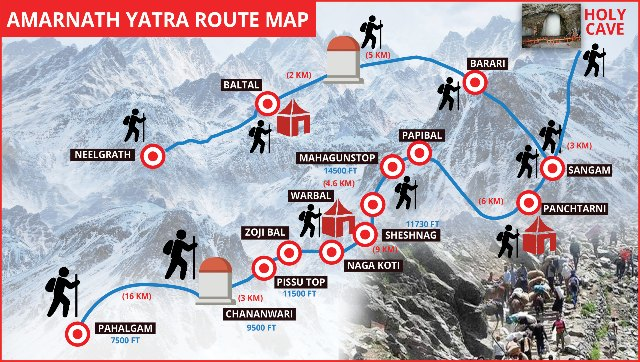Geography
Amarnath Flash Flood
- 11 Jul 2022
- 6 min read
For Prelims: Flash Floods, Cloud Bursting, Fundamentals of Physical Geography, Indian Physical Geography, Disaster Management Bodies, NDRF, SDRF
For Mains: Geographical Factors for Flash Floods and Cloud Bursting, Disaster Management Bodies and their role, Fundamentals of Physical Geography, Indian Physical Geography
Why in the News?
Recently, flash floods caused landslips near the Baltal base camp in central Kashmir’s Ganderbal area.
- At least 13 people, mainly Amarnath pilgrims, have died and dozens went missing after flash floods.
What do we Need to know about Amarnath?
- Amarnath Temple is a Hindu shrine located in Jammu and Kashmir, India.
- The cave is situated at an altitude of 3,888 m, about 100 km from Srinagar, the summer capital of Jammu and Kashmir, reached through Pahalgam town.
- The shrine represents an important part of Hinduism.
- The Amarnath yatra resumed after three years this year.
- The annual yatra has twin routes of Pahalgam in south and Sonamarg in central Kashmir to reach the cave shrine:
What do we know about the Amarnath Flash Flood?
- Flash Flood:
- These are sudden surges in water levels generally during or following an intense spell of rain.
- These are highly localised events of short duration with a very high peak and usually have less than six hours between the occurrence of the rainfall and peak flood.
- The flood situation worsens in the presence of choked drainage lines or encroachments obstructing the natural flow of water.
- Causes:
- It may be caused by heavy rain associated with a severe thunderstorm, hurricane, tropical storm, or meltwater from ice or snow flowing over ice sheets or snowfields.
- Flash Floods can also occur due to Dam or Levee Breaks, and/or Mudslides (Debris Flow).
- In areas on or near volcanoes, flash floods have also occurred after eruptions, when glaciers have been melted by the intense heat.
- The intensity of the rainfall, the location and distribution of the rainfall, the land use and topography, vegetation types and growth/density, soil type, and soil water- content all determine just how quickly the Flash Flooding may occur, and influence where it may occur.
What do we know about Cloudburst?
- About:
- Cloudbursts are short-duration, intense rainfall events over a small area.
- It is a weather phenomenon with unexpected precipitation exceeding 100mm/h over a geographical region of approximately 20-30 square km.
- In the Indian Subcontinent, it generally occurs when a monsoon cloud drifts northwards, from the Bay of Bengal or the Arabian Sea across the plains then on to the Himalaya that sometimes brings 75 millimetres of rain per hour.
- Occurrence:
- The relative humidity and cloud cover is at the maximum level with low temperature and slow winds because of which a high amount of clouds may get condensed at a very rapid rate and result in a cloudburst.
- As temperatures increase, the atmosphere can hold more and more moisture and this moisture comes down as a short very intense rainfall for a short duration probably half an hour or one hour resulting in flash floods in the mountainous areas and urban floods in the cities.
- Cloudburst are Different from Rainfall:
- Rain is condensed water falling from a cloud while cloudburst is a sudden heavy rainstorm.
- Rain over 100mm per hour is categorized as a cloudburst.
- The cloudburst is a natural phenomenon, but occurs quite unexpectedly, very abruptly, and rather drenching.
- Consequences of Cloudbursts:
- Flash floods
- Landslides
- Mudflows
- Land caving
Why do cloudbursts occur in hilly areas like Amarnath?
- In hilly areas, sometimes saturated clouds ready to condense into rain cannot produce rain, due to the upward movement of the very warm current of air.
- Instead of falling downwards, raindrops are carried upwards by the air current. New drops are formed and existing raindrops increase in size.
- After a point, the raindrops become too heavy for the cloud to hold on to, and they drop down together in a quick flash.
- A study published in 2020 examined the meteorological factors behind the cloudburst over the Kedarnath region, where a cloudburst aided the devastating 2013 floods.
- It found that during a cloudburst, the relative humidity and cloud cover was at the maximum level with low temperature and slow winds.





